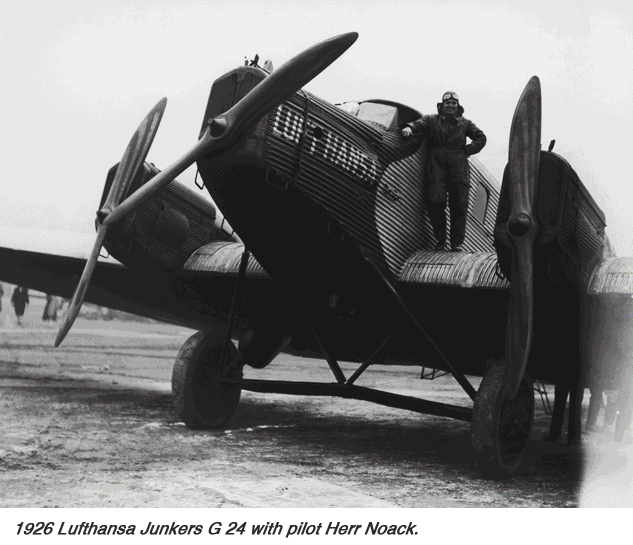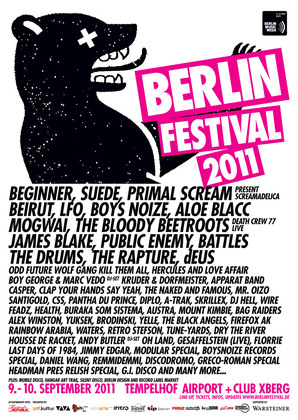| 

Deutsche Lufthansa
once commenced their operations here.
Thousands of so-called Western Allies’
DC-3 ‘raisin bombers’ landed here during the Soviet’s
Berlin blockade in order to fly in vital supplies to the free half of
the city during the early stages of the cold war between June 1948 and
May 1949.
Tempelhof, the once crown jewel
in the German airport landscape, is located just a stone’s throw
from the capital’s vibrating center and, a great airport for 85
years.
Tempelhof was shut down on October
30, 2008, marking that Thursday as one of the gloomiest days in the
long-standing and glorious German aviation history.
It was Berlin’s Mayor Klaus
Wowereit who decided to lock the doors of this once formidable and futuristic
airport after eight and a half decades.
At that time, many Berliners could
not understand why Tempelhof closed since Berlin’s air traffic
was constantly increasing at annual rates of 8 percent.
Beautiful by any measure, Tempelhof
is ideally located near the famous Reichstag, the Brandenburg Gate,
the vast number of embassies and the shopping centers in Friedrichstrasse
or Kurfuerstendamm.
This geographical closeness to the
center of economic and political power made departures and landings
at Tempelhof highly convenient to a clientele that rushed to the city
primarily for business – artists, show stars, diplomats, architects,
lawyers and all those who belonged to the stratum that can afford to
travel first and business class.
These groups traditionally were
eyed with some skepticism by the Berliners, especially in the eastern
and formerly communist-reigned part of town, who— at least a high
percentage of them— depend on transfer money given by the state
to subsidize their daily living.
In this atmosphere of hidden envy
and increasing social contrasts, a facility like Tempelhof was eyed
as an ideal place to be sacrificed.
So the Wowereit administration did
the deal as mentioned on October 30 by locking the doors once and for
all.
What follows is Tempelhof as a historical
site enjoying state protection – a new urban space for picnics
and sightseers and roller skaters gliding around where revenue passengers
once roamed.
It now costs millions of euros a
year to prevent Tempelhof from cracking and crumbling.
In a nutshell, Tempelhof’s
birth, rise and fall demonstrate the entire country’s ups and
downs for almost a century.
First there was hope and aspiration:
in 1923, Berlin decided to build an airport close to the city center
with integrated shopping malls, hotels and restaurants.
In those early days, a visionary
concept soon turned Tempelhof into the busiest airport in all of Europe.
Then in 1934, shortly after the
Nazis had taken over power, they decided to completely rebuild the entire
place.
The architectural result was an
elliptic airport building that was 1.2 kilometers in length, then the
largest single construction worldwide.
With the fall of the “Third
Reich” and the destruction of most of Berlin, new life was unexpectedly
breathed into Tempelhof, especially after 1948, when the Soviets decided
to shut all roads and railroads that linked the western parts of the
isolated city with the free world.
Without Tempelhof and the countless
DC-3 & 6 and other flights that brought in everything needed for
daily life by the trapped Berliners, from beverages to food, machines,
garments and even coal to heat their dwellings, Stalin and his regime
would have succeeded with their 11-month blockade.
During that extremely tense time,
millions of tons landed at Tempelhof, making the facility by far the
biggest cargo airport in the world, if only for less than a year.
But the whole world was lifted by
the air cargo story in Berlin.
Who knows how many young men (and
older ones, too) were bitten by the inspirational story of an around-the-clock
air cargo airlift that actually breathed life back into a great world
city.
During this time, it can be confirmed:
Tempelhof saved Berlin. And thus, Berlin continues to save Tempelhof.
The next chapter for Tempelhof started
when East and West Germany reunited in 1989, with Tempelhof becoming
the home of private aviation and attracting a number of commercial airlines
to operate there.
But the death knell had already
begun to ring in the late 90’s, when the city opted for a single
airport concept.
Now currently rebuilding and enlarging
the already sprawling Schoenefeld, Tempelhof is closed, followed by
Tegel soon as newly constructed “Berlin Brandenburg International”
(Schoenefeld) is inaugurated.
According to the set schedule, this is expected to happen as early as
2012.
Traffic experts argue that this
single airport concept is highly opportunistic to mainly please the
voters of the city’s leftist government.
Tempelhof, they argue, was an indispensable
vein for fast-linking the German capital with other cities, much like
LaGuardia is to New York and Reagan is to Washington, D.C., as “close
in” convenient airports that serve a need and make money all around.
 In Berlin, a ride by subway or cab
from Tempelhof to the Brandenburg Gate takes about 15 minutes, whereas
remote Berlin Brandenburg Int’l (BBI) is about one hour off the
downtown area, both by public transport or taxi.
In Berlin, a ride by subway or cab
from Tempelhof to the Brandenburg Gate takes about 15 minutes, whereas
remote Berlin Brandenburg Int’l (BBI) is about one hour off the
downtown area, both by public transport or taxi.
What the Soviets failed to accomplish
has now been executed by the mediocre coalition of Berlin’s Senate:
the death of a legendary city airport.
Tempelhof has been used since closing
to host numerous fairs and events.
The first major events included
the BREAD & BUTTER fashion tradeshow in July [89][90] and the Berlin
Festival 2009 concert in August.[91]
It also hosts the Berlin Marathon
fair each September.
Fairs are held in the hangar.
In September 2010, Tempelhof hosted
the Popkomm, the international world’s music and entertainment
business meeting place and was one of the most important locations of
the first Berlin Music Week.
Tempelhof today is being developed
as a city park with an estimated €60 million allotted by the city
toward developing, with an expected completion date of 2017.
Last May 2010, the outfield was
festively opened as Berlin's largest public park named "Tempelhofer
Feld."
More than 200,000 Berliners visited
the park to enjoy its wide-open spaces for recreation ranging from biking
and skating to baseball and kiting.
Grün Berlin, a company that
also looks after several other gated parks in Berlin, maintains the
grounds.
Plans are afoot to have Tempelhof
host the 2017 IGA, Germany’s world horticultural exhibition.
In the meantime, the grande-dame
of all airports is still there, home to a rich history that was felt
far beyond her gates, and remains among the greatest airports of the
world.
Heiner/Geoffrey |
